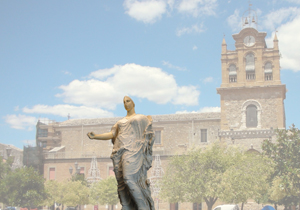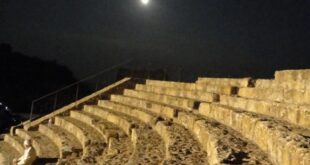 Aidone con il suo centro storico, il “Museo Archeologico” la notevole cittadella archeologica di Morgantina costituisce una meta turistica di grande interesse, che incontra il gradimento di chi sa apprezzarne il meraviglioso patrimonio culturale, il ragguardevole patrimonio naturalistico, la capacità di accoglienza della sua popolazione.
Aidone con il suo centro storico, il “Museo Archeologico” la notevole cittadella archeologica di Morgantina costituisce una meta turistica di grande interesse, che incontra il gradimento di chi sa apprezzarne il meraviglioso patrimonio culturale, il ragguardevole patrimonio naturalistico, la capacità di accoglienza della sua popolazione.
Aidone, sorge sui monti Erei, a 850 mt circa sul livello del mare, a 35 Km da Enna e a 9 km da Piazza Armerina. Ricca di boschi e di piante rare, col suo Belvedere si affaccia su un vasto ed incantevole paesaggio.
Da visitare il Museo Archeologico ospitato nel secentesco Convento dei Cappuccini, che espone i reperti della vicina Morgantina, la quattrocentesca chiesa di San Domenico dall’originale facciata bianca con bugnato a punta di diamante, la Chiesa Madre, dal magnifico portale del Duecento, la chiesa di santa Maria la Cava di origine normanna, le deliziose chiesette della Madonna delle Grazie e di Sant’Antonio Abate, la cinquecentesca Chiesa di Sant’Anna con il toccante Crocifisso attribuito a Frate Umile da Petralia e, poco discosta, la chiesa di San Giovani dei Templari. Dominano su tutto i ruderi del castello normanno, il Castellaccio, dal cui pianoro si gode un panorama mozzafiato a 360° sulla Piana di Catania e l’Etna e sui monti Erei.
Nei pressi di Aidone c’è uno dei siti archeologici più interessanti di tutta la Sicilia: il parco archeologico di Morgantina che presenta una città ellenistica nella sua interezza, gli edifici pubblici che gravitano intorno e sull’agorà, le numerose e splendide case nei quartieri residenziali, i santuari le necropoli.
Dal dicembre 2009, Aidone e il suo Museo sono al centro dell’attenzione dei media nazionali e stranieri per i cosiddetti “rientri” dai musei americani di reperti trafugati, ritrovati e restituiti dai maggiori musei americani: gli Acroliti arcaici delle dee Demetra e Kore, veri capolavori dell’arte acrolitica, i magnifici Argenti16 pezzi di raffinatissima e artistica oreficeriea ellenistica, e infine la magnifica statua di Demetra di scuola fidiaca, conosciuta come Venere di Malibù o di Morgantina che dal 17 maggio 2011 è esposta, insieme agli altri reperti in una sala a lei dedicata nel Museo Archeologico
COME SI ARRIVA AD AIDONE
Da Catania o da Palermo: da Autostrada A19, uscire a Mulinello o Enna e proseguire in direzione Piazza Armerina. SS 117bis, uscire a Piazza Armerina Nord e immettersi sulla SS 288 in direzione Aidone.
Percorso alternativo: da Catania, A19 uscita Motta Sant’Anastasia, immettersi sulla SS 192 fino al bivio Iannarello, imboccare la SS 288 e percorrerla fino ad Aidone.

About 35 kilometrres South of Enna, you come to Aidone, a town of ancient origins dating back to the eleventh century. If you go there on May 1 st, you can witness the pilgrimage to the “black” saint, San Filippo Apostolo in the church of “Santa Maria La Cava”, when thousands of people come to Aidone on foot, often barefoot. Then, after stopping off at the Municipal Villa with its spectacular view, go firstly to the archaeological museum, in the ex-Capuchin convent from the 1600’s, where remains from the nearby town of Morgantina are on display. In Piazza Umberto you will find the 18th century town hall and the church dedicated to Pope San Leone. In via Roma you will see the diamond pointed white ashlar-work of the 15th century church of San Domenico, and the main church with its magnificent 13th century door. The town is totaly dominated by the ruins of the Norman castle, while at the foot of the steep via Erbitea you will find the small churches of the Madonna delle Grazie and St. Antonio Abate. Finally, do not miss the 16th century church of Sant’Anna, with its precious wooden crucifix attributed to Brother Umile de Petralia, and, a little farther on, the small church of San Giovanni dei Templari.
The Normanni built up it high on a cliff, fused with the cliff on which it has been founded. The popular tradition defines it “impregnable”. It is said has accommodated, in 1411, Queen Bianca of Navarre. During the war of the Vespro the castle accommodated the French garrison, that it perished during I besiege.
Going trough Aidone’s streets you’ll easily find the old capuchins monastery (XVII SEC), seat of the archeological museum. There you’ll be able to begin to know Morgantina, the mytical town rised a thousand years before Christ, in the spot where it already existed a village going back to the first age of bronze; in those hills which now are called” cittadella and orlando’s greenhouse. In one of the cloister sides you find the first room, with its collection of architectonic ornaments which gave the opportunity to establish the different ages of the primitives settlings. You can examine the ceramics and its ornaments, the earthenwares in the form of horn and the most old stone and bone utensils. The vases, on the contrary, come from the morgets, the founders of Morgantina. Now you can go upstairs, and you’ll find yourselves in the citadel’s room, where you’ll be able to admire the proof of the Hellenic presence in Morgantina, around 550 a.c. There we find shutters in terracotta from a gorgonic mask, leonine and with a menade head, which decorated the outside of the buildings and, besides, the fragments of some terracotta statues which had a votive function . In the serra orlando’s room you’ll come back to the ages near to the third century before Christ. It’s the most magnificient age of the town that produced a flourishing wave of religious art, as it witnesses the Persefone’s bust in terracotta and the ex-votos of a culture which venerated Demetra, Persefone, Afrodite and Hermes. It’s extraordinary the working of the cup nicknamed “ MEGARESE” that comes from a necropolis of the same age on the slope to the south of serra orlando and very delicated the features of a little head of Persefone with diadem. In the fourth and fifth room, at the lower floor, there is a very rich exibition of the daily life objects subdivided for subjects.
Six kilometres from Aidone, in the district of Serra Orlando, is one of the most important archaeological sites of Europe, Morgantina. Discovered in 1955 by a team from the American University of Princeton, during excavation compaigns, still on going today, which uncovered a series of treasures belonging to civilisations which succeeded one another in Sicily. The first settlement belongs to an Italic tribe, the Morgeti, which settled here in prehistoric times, giving the town its name. The town became Greek in the 6th century BC and reached its maximum splendour between the 4th and the 3rd centuries BC, as can be seen from the monuments uncovered. Try to walk along the “stoa” thinking of the life which bustled under this very same sky. Imagine yourselves on the steps of a thousand places during major perfonmances, which nowadays, in summer, are regularly repeated. But Morgantina is not just a theatre. Go in search of the ancient lava grindstones, the aristocratic homes, above the space reserved for the market place and its shops, stop in front on of a house and its floor writings wishing long life, done in mosaic, visit the house of Ganimede with its countyard surrounded by stone columns, try to imagine the funeral rites at the necropolis and the furnace and the crowd which fervently recited prayers in the hundred feet long temple. At this point you could possibly go back to the museum of Aidone to see the features of the veiled woman, the impenetrable face of Persephone, Venus bathing and the magnificent woman lying down, since now you know where they came from..
 EnnaVivi Magazine della provincia di Enna
EnnaVivi Magazine della provincia di Enna



